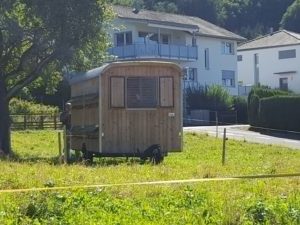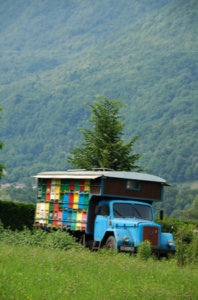Mobile beekeeping
After the recent long posts on DIY foundationless frames using bamboo skewers, starter strips and hive autopsies, something in a slightly lighter vein this week.
Migratory beekeeping is the term used for moving your bees to places where they are needed e.g. to California for almond pollination, or moving your bees to crops or forage for the nectar – and hence honey – they will collect e.g. taking your bees to the heather.
About 75% of all the colonies in North America are used for almond pollination. This is the largest managed pollination event in the world, with colonies being ‘rented’ for about $200 for the 4-6 week pollination period before being shipped off to pollinate other crops in a near year-long clockwise rotation round North America.
At the opposite end of the spectrum is the beekeeper who, at unholy-o’clock sometime in early August, loads a couple of sealed colonies into the car and drives them up to the moors in the hope that the rains hold off and the bees can collect enough nectar for a few jars of heather honey.
There’s more than one way to do it
Here’s the last of the photos that Calum sent me a couple of months ago – a mobile bee caravan in Germany. I love the way it’s simply parked on what looks like the village green, with a bit of tape stretched around it to keep people at a safe distance.
It might be a bit small and poorly lit to conduct inspections inside and the photo seems to show the beekeeper looking at a frame standing outside, behind the caravan. However, the simplicity of being able to hitch it to the car and drive off to take advantage of better forage is really appealing. The ‘top opening’ hive we’re familiar with may not be ideal for these types of small trailers where headroom can be limited. One solution is to use a hive that opens from the rear, such as the AZ hive from Slovenia. The AZ acronym is derived from Anton Žnideršič (1874-1947), a famous Slovenian beekeeper and inventor of the hive and hive house. There’s a comprehensive introduction to this hive type by Mark Chorba available online (large PDF) which discusses the benefits (and disadvantages) … and has some excellent illustrations including the truck for mobile beekeeping shown on the right.
While we’re on the topic of mobile beekeeping, I discovered this (poor quality) video of someone moving a hive to the moors … by bicycle. I know one or two beekeepers who travel between apiaries by bike, but this shows a tremendous level of dedication. And strength.
Can you imagine the return journey after a successful early autumn on the heather? The hive, now weighed down by a couple of filled supers, together with the descent from the moors, means you’d need forearms like Popeye to use the brakes and maintain control.
Mobile extracting
In addition to mobile beekeeping using a bike trailer there’s now mobile extracting using a trailer. The snappily-named International Honey Product Ltd. make (or did, they have disappeared!) a 120 frame mobile extractor (jump to ~36s. to skip the intro).
Although there are a few bees flying around inside the trailer in the video it’s not the orgy of robbing you might expect. Apparently this is because the entrances and exits have air curtains that effectively separate the two environments. Clever.
They claim to be able to process over three thousand pounds of honey an hour, so I’ll need to scale up a bit before being able to justify the purchase.
For the moment my mobile beekeeping is restricted to my hivebarrow …


Join the discussion ...